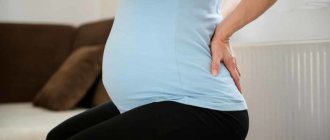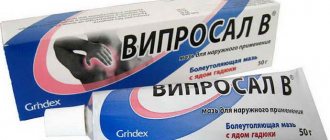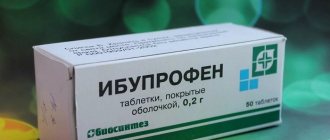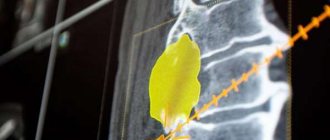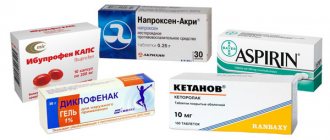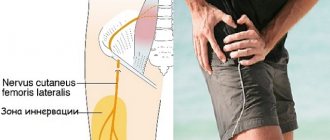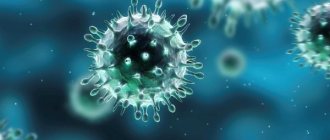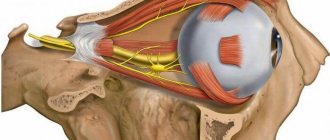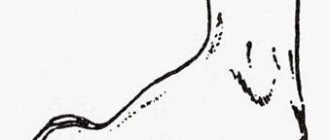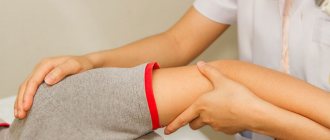The nervous system is responsible for sensory, motor activity and the functioning of the endocrine and immune systems in the human body. The development of the inflammatory process in the nerve roots causes pain and limited mobility. It is difficult for a person to move, the sensitivity of joints and soft tissues is impaired. Inflammation of the nerve in the leg, the symptoms of which cause significant discomfort, appears more often as a concomitant pathology against the background of other diseases of the spine or viral damage to the body.
Symptoms of a pinched nerve in the leg
If the nerve supplying the leg is pinched, the patient most often complains of an acute pain attack that affects the thigh and spreads to the lower leg and foot. Acute pain syndrome is the main symptom of the disease, allowing one to think about the appropriate diagnosis.
It is worth keeping in mind that pain often does not develop spontaneously, but under the influence of external factors. Factors that provoke an attack include:
- prolonged exposure to the cold;
- active physical activity for which the body is not adapted;
- prolonged stay in an awkward position that causes discomfort;
- lifting heavy objects.
Symptoms of a pinched nerve in the leg
Along with a pinched nerve in the leg, due to these factors, a pinched sciatic nerve or, as it is also called, sciatica, can develop. However, the symptoms may be similar, and differential diagnosis is difficult even for experienced doctors.
Pain occurring in the leg is usually accompanied by the following patient complaints:
- normal gait is sometimes disrupted to the point that the person completely loses the ability to walk during an attack;
- the sensitivity of the affected limb to external influences changes, burning and tingling may be felt;
- there will be a restriction in the normal range of movements, the ability to freely move your fingers, bend and straighten your knee, and make movements in the ankle area will disappear;
- a person will notice that his feet begin to sweat excessively.
Assessing all the symptoms will help your doctor suspect a pinched nerve in your leg, but remember that this diagnosis is not made based solely on symptoms.
Symptoms
Symptoms indicating that a nerve in the leg is pinched often begin with pain in the lumbar region, sacrum in case of pinched root in the natural openings of the bone, or in the area of the buttocks in the presence of piriformis muscle syndrome. When pinching occurs, the pain begins to radiate to the leg, initially to the back of the thighs, then spreading to the lower leg and foot.
In a situation where a nerve in the leg is pinched, certain features are noted:
- acute onset;
- the appearance of sciatica;
- persistence of symptoms not in the acute period;
- accompanying pain with characteristic symptoms.
When exposed to predisposing factors and at the same time the presence of pathology of the spine and joints in the body, during pregnancy or other inflammatory or inflammatory-degenerative processes, pinching may occur. It manifests itself primarily as acute pain in the lumbar and sacral region, along the sciatic nerve. The pain may be stabbing, burning or cutting. The pain intensity is pronounced.
After the attack passes, a feeling of aching pain remains in the leg. Increased discomfort occurs when walking, standing for a long time, maintaining a sitting position, as well as when coughing, sneezing and laughing. In this case, a pinched nerve in the leg is often combined with changes in the functioning of the musculoskeletal system (MSA) and autonomic disorders.
The patient's gait is disturbed and difficulties arise with the mobility of the limbs in the joints (knee, ankle). There are also difficulties in bending the fingers and toes. Autonomic abnormalities include: changes in sensory innervation in the form of numbness, paresthesia, burning and tingling. Possible increased sweating of the feet.
Causes of pinching
There is a wide range of reasons that can lead to the development of pinching.
| Osteochondrosis of the spinal column | Leads to compression of the spinal roots, which can result in pinching of one of the nerves responsible for the innervation of the leg |
| Protrusion of intervertebral discs | Due to the protrusion of part of the intervertebral disc, the nerve root that supplies the legs may also be compressed. |
| Spondylolisthesis of the spinal column | In this case, one of the vertebrae changes its position, moving slightly forward, which also leads to a pinched nerve |
| Herniated disc | Protrusion of the contents of the disc can also lead to partial or complete compression of one of the nerves if the herniation is located close to the hole through which the nerve exits |
| Tumor formations | If located close to the exit point of the nerve, it can cause pinching |
| Piriformis syndrome | Usually accompanied by pinching of the sciatic nerve, resulting from hypertrophy or inflammation in the piriformis muscle |
| Pregnancy | A pathology in which the growing uterus can put pressure on the spinal column, causing compression of the roots |
| Lesions of the rectum, such as paraproctitis or abscesses | Also puts pressure on the spinal column |
Causes of a pinched nerve in the leg
In addition to the main factors that trigger the pathological process, there are additional ones, which include:
- polyradiculoneuritis;
- herpes, spondyloiditis or spondyloarthrosis in the area of the sciatic nerve or the roots of the nerves that provide movement of the leg;
- polyneuropathic changes in various diseases of the endocrine system;
- the effect of infectious pathologies;
- poisoning with toxins and heavy metals;
- pathologies of a demyelinating nature;
- heavy weight;
- inflammation of the pelvic organs.
Causes
The most common cause of pinched nerves is degenerative changes in the spinal column - osteochondrosis, hernias, protrusions, spondyloarthrosis. In old age, this symptom occurs against the background of arthrosis of the hip joint (coxarthrosis), in which pain in the hip radiates to the lower back.
In some patients, nerve compression is caused by myofascial syndrome - a painful reflex muscle spasm caused by hypothermia, physical overload or fatigue.
In addition, the cause of pain is irritation of the ligamentous apparatus and musculoskeletal structures: in this case, the pain syndrome is felt deep in the tissues, usually on both sides of the body, and can radiate (give) to one or both hips.
A pinched nerve due to osteochondrosis may be accompanied by numbness and weakness of the muscles of the lower extremities.
Often, nerve compression is associated with overheating of the back (for example, during sports training) and further hypothermia; a sharp turn of the body or prolapse of an intervertebral disc.
Chronic radiculitis often develops as a result of infectious pathologies, which include:
- flu;
- tuberculosis;
- scarlet fever;
- malaria;
- syphilis;
- sepsis.
One of the possible causes of nerve damage in the lower back may be intoxication, both of exogenous and endogenous origin. Endogenous intoxication leads to poisoning of the body with substances formed due to metabolic disorders in gout or diabetes. Exogenous intoxication is caused by chemical compounds coming from the outside - for example, alcohol and salts of heavy metals.
In rare cases, a tumor or metastases in the spine can put pressure on the nerve.
The high-risk group includes people suffering from chronic diseases of the spine, those who are overweight, as well as those who are engaged in heavy physical work or are forced to remain in a stationary position for a long time.
Diagnosis of the disease
A pinched nerve in the leg is a pathology accompanied by a fairly clear clinical picture. Even if the patient cannot clearly name the factors that triggered the onset of the disease, a specific clinical picture, where the leading symptom is pain, will indicate to the doctor where to look for pathology.
Diagnostic measures in the case of a pinched nerve in the leg are prescribed not to clarify the diagnosis, but to determine the cause that provoked the pathology. Establishing the cause of the disease allows you to combat it most effectively.
Diagnosis of pinched nerve disease in the leg
The following techniques can be used:
- radiography, which allows you to determine the presence of pathological changes in the spinal column, as well as in bone structures;
- CT and MRI, which allow you to clarify the diagnosis if radiography does not provide enough data or does not allow you to fully assess the cause of the pathology;
- Ultrasound of organs located in the pelvis will help exclude the inflammatory nature of the disease;
- Scintigraphy is performed if there is suspicion of tumor development.
In the diagnosis of the disease, the collected anamnesis and neurological status of the patient play an important role. When examining the neurological status, it is necessary to pay attention to decreased sensitivity in the affected limb, revitalization or decreased tendon reflexes.
Prevention
Of course, preventing a disease is much healthier and cheaper than treating it later.
The easiest way is to follow basic recommendations that significantly reduce the risk of getting sick:
- exercise regularly;
- sleep about six to eight hours a day;
- take walks in the fresh air as often as possible;
- choose a mattress that is not too soft;
- wear comfortable shoes and do not “overuse” high platforms;
- arrange proper rest in case of physical fatigue;
- dress according to the season to avoid hypothermia.
It is worth understanding that even if the symptoms are not pronounced, you should definitely consult a doctor. It is known that attacks do not spoil life as much as constant pain, since they appear from time to time and you can temporarily forget about the existence of the disease until the next attack.
However, the disease will not go away on its own, and negligence and carelessness will worsen the situation.
How to treat a pinched nerve in the leg?
An acute attack of the disease begins to be treated with the establishment of a special daily regimen. The patient's mobility is limited, and he is recommended to lie on some hard surface. It is important to remember that a pinched nerve cannot be heated. This is explained by the fact that heat increases the swelling that forms during pinching. Also, during the period of exacerbation, gymnastics and active movements are prohibited. They are introduced into the regime when the pain attack has been stopped.
How to treat a pinched nerve in the leg?
Medicines that can be used:
- products for external use, such as gels and ointments, which help relieve inflammation and relieve pain (Ketonal, Fastum gel, Nurofen, Nise, etc.), non-steroidal anti-inflammatory drugs are mainly used;
- if the pain syndrome is severe, doctors recommend locally irritating ointments, for example, Analgos or Nicoflex;
- if the pain is not relieved with the help of local remedies, it is possible to use their analogues in tablets for oral administration, as well as in the form of intramuscular injections (drugs such as Ibuprofen, Nimesulide, etc. are used);
- after pain relief, vitamins from group B are used, which allow the damaged nerve to recover;
- muscle spasms can be stopped with the help of antispasmodics, for example, Mydocalm.
An important element of therapy is the patient’s diet. It is recommended to exclude all harmful foods from the diet. Food must be received warm; it is better to give preference to liquid food. Liquid food will help fight constipation, which can exacerbate pinching.
Treatment for a pinched nerve
Treatment consists of releasing the nerve ending from compression. This requires complex therapy:
- massage course;
- taking non-steroidal anti-inflammatory drugs;
- combating the existing disease that causes the compression.
A pinched nerve in a knee or joint is treated with massage only when the pain is relieved. After a course of complex treatment, it is necessary to eliminate the underlying disease. Most often, a pinched nerve provokes osteochondrosis.
Treatment of the underlying disease should not be delayed so that the pain does not return again.
Both ointments and tablets help combat the problem. If taking them does not give the expected effect, the neurologist prescribes a novocaine blockade. It allows you to quickly relieve pain.
If a pinched nerve in the leg occurs due to a large intervertebral hernia or tumor, the patient is scheduled for surgery. During surgery, doctors remove the damaged vertebra (part of it). This eliminates the cause - the physical source of pinching. Within a month, the patient can lead a normal life.

Drug therapy
If there are no stomach problems, then non-steroidal anti-inflammatory drugs are allowed for pain. They analgesize and treat the damaged area. Among the most popular drugs:
They should not be taken for more than 7 days. With long-term use of these medications, side effects occur. For those who have problems with the gastrointestinal tract, the doctor prescribes injections of Declofenac. These injections quickly relieve pain and inflammation that accompany a pinched nerve.
Injections and tablets can have the same name and have the same spectrum of action as products for external use.
Viprosal ointment or Fastum-gel is rubbed into the sore spot. The analgesic effect occurs within 20-30 minutes after application. The active component of the gels causes a sharp flow of blood to the pinched area, eliminating inflammation and swelling.
How to prevent the development of neuritis of the lower extremities?
Among the preventive measures are the following:
- Maintain proper nutrition with an emphasis on foods rich in B vitamins. And for overweight people, a special diet will be required to reduce stress on the legs.
- Regularly performing therapeutic foot exercises.
- Relaxing foot baths. Especially suitable for lovers of high heels.
- Wearing special orthopedic shoes when playing sports.
Hypothermia and dampness, as well as stressful situations, can provoke inflammation of peripheral nerve endings. And most importantly, you should not self-medicate, and at the first symptoms, be sure to see a specialist. After all, advanced neuritis of the lower extremities can lead to paralysis and even disability.
Physiotherapeutic effects
Physical therapy used to treat a pinched nerve in the leg focuses on strengthening the muscles and stretching them slightly, preventing spasms. Such an effect helps reduce muscle pressure on an already injured nerve, removing one of the elements that provokes the development of pain.
Physiotherapeutic techniques are mainly based on warming up, which precludes their use in the acute period of the disease. Physiotherapy is possible only when the acute period of the disease has already passed and remission has begun. Otherwise, exposure will only worsen the disease rather than alleviate the symptoms.
The following techniques can be used:
- electrophoresis with the introduction of drugs;
- phonophoresis with drug administration;
- magnetic therapy;
- UHF;
- paraffin applications.
Physiotherapeutic treatment for a pinched nerve in the leg
Physiotherapeutic effects allow the patient to improve blood circulation in the problem area and eliminate muscle spasms. Physiotherapy can also help relieve swelling if it is not caused by an inflammatory process that occurs during the acute period of pinching.
It is considered possible to use reflexology for pinched nerves in the leg. This procedure will also help cope with pain and relieve swelling, but it should only be carried out under the close supervision of a professional.
What to do if conventional treatment does not help?
The ineffectiveness of drug treatment serves as the basis for surgical intervention . Typically, decompression is used for pinched nerves in the lower back. During the operation, hernial formations and osteophytes are removed, tumors are excised, and the damaged nerve is freed from elements pressing on it.
The rehabilitation period after abdominal surgery takes about 6 months, after endoscopic surgery it takes up to two months.
Acute pain symptoms can be relieved on your own , at home, using warm rubs and compresses, however, if possible, it is better to go to the clinic as soon as possible. Signs of a pinched nerve in the lower back can be mistaken for symptoms of another disease, and only a doctor can make the correct diagnosis and prescribe treatment.
A pinched nerve in the spine is a pathological condition that occurs due to compression of certain nerve endings. We are talking about those that extend to the nearest vertebrae in the spinal cord. In 30% of cases, the cause of this phenomenon may be a hernia, protrusion or spasmed muscles. This condition is associated with obvious painful sensations. The most common types of pinched nerves in this area are pinched sciatic and cervical nerves. It is equally likely to occur in both men and women after 35 years of age.
The content of the article:
Symptoms of a pinched nerve in the spine Causes of a pinched nerve in the spine Diagnosis of a pinched nerve in the spine Treatment of a pinched nerve in the spine
How does a person feel before an attack develops?
Signs of occipital neuralgia indicate the appearance of extensive inflammation. The main symptom is pain localized in the back of the head. With neuralgia, the pathological process involves the meninges, cervical spine, muscles and skin. Often, adult patients experience paroxysms that last a long time. Inflammation of the intervertebral joints causes neuralgia - signs of disc pathology are clearly expressed. The acute form of the disease is characterized by the development of a crisis.
In older people, damage to the trigeminal nerve occurs due to caries, sinusitis, tumor of the cranial fossa, and herpetic infection. The manifestation of neuralgia is a sudden onset attack, for example, after touching the skin of the face or blowing wind. If pain radiates to the ear, inflammation of the glossopharyngeal nerve is suspected.
Traditional methods of treatment
Many people try to cope with a pinched nerve in the leg using traditional medicine techniques. It is important to remember that the recipes offered by this branch of alternative medicine can only help to cope with the symptoms of the disease. At the same time, it will not be possible to eliminate the cause of the disease, which means further progression of the disease without treatment from a specialist.
Traditional medicine can be used as an adjuvant against the background of the main therapy. For example, it can significantly alleviate the patient’s condition if he suffers from severe pain.
Traditional methods of treatment for pinched nerves in the leg
The following recipes are often used:
- rubs and lotions based on decoctions and tinctures made using herbs that have anti-inflammatory properties;
- baths in which a variety of essential oils or herbs are added, which also have an anti-inflammatory effect;
- Tinctures of elecampane or horse chestnut can be used internally in small quantities;
- it is possible to use ointments and poultices based on bee products (for example, applying a cake of honey and flour or an ointment based on propolis and calendula to the affected area).
One of the advantages of traditional medicine is that it combines well with the main therapy and can be used in parallel. This is especially true if we are talking about taking painkillers, against the background of which treatment is carried out with rubbing and compresses or ointments.
The main disadvantage of treatment with folk remedies is that due to the use of highly allergenic components (especially beekeeping products), allergic reactions often develop. That is why, when using traditional medicine, a preliminary consultation with a doctor is necessary.
Methods of prevention and control of symptoms
When the first signs are detected, you should find out the cause of the disease and treat it. To relieve fatigue and tension in the legs, baths with relaxing oils and massage will help. If there is a deficiency of vitamins and microelements, it is necessary to reconsider the diet. To calm the nervous system, sedatives are used - valerian, motherwort. As a preventative measure, ensure adequate time for rest and sleep. Avoid increased physical activity.
In case of complications, consult a doctor for examination, diagnosis and treatment of a specific disease. Timely provision of assistance will eliminate the occurrence of pathologies and various diseases of the joints and blood vessels.
How to relieve a migraine attack
Treatment of neuralgia, accompanied by the appearance of a “cluster” headache, involves influencing the cause of the disease. For therapy, the doctor suggests the medicine Mexiletine, which eliminates discomfort and has an analgesic effect. This type of neuralgia can be cured using the following medications:
- Amitriptyline;
- Diazepam;
- Chimes.
How to treat neuralgia if attacks occur frequently, the doctor will tell you after examining the patient. For the treatment of acute conditions, drugs are used:
- Ergotamine;
- Caffeine;
- Seduxen;
- Pipolfen.
In severe cases, the patient is recommended to use the drug Dexamethasone to relieve an attack. The drug has anti-inflammatory activity. It eliminates pathological reactions in neuralgia - treatment is aimed at suppressing unwanted immune processes.
Often, glucocorticoid drugs used to relieve neuralgia cause side effects.
Exercises for pinching
Therapeutic gymnastics in cases of pinching can take place both in the gym and at home. The main thing is that the patient does not try to engage in physical activity, even therapeutic, during the acute period of the disease, since at this time even light exercise will aggravate the symptoms.
Gymnastics must be performed without haste, working not on the number of exercises performed, but on the result. If any of the exercises provokes pain, it is recommended to abandon it.
Exercises for a pinched nerve in the leg
If a nerve is pinched in the leg, the following complex is suitable:
- Walk for several minutes with high knees at each step;
- The torso is tilted, for convenience, the legs are set shoulder-width apart;
- you can, holding the back of a chair, alternately lift each leg up as much as your body allows;
- flexion and extension of the knee joint are done from a standing or lying position;
- holding the back of the chair, make circular movements with one leg, and then repeat the movements with the other leg (movements must be performed both clockwise and counterclockwise!);
- in a position on all fours, swing each leg alternately upward;
- lying on your side, do pull-ups of your legs to your chest, as if curling up into a ball.
The process of treating a pinched nerve in the leg is not quick, and ideal results cannot be achieved immediately. If a person wants to get rid of a problem, he must carefully follow the doctor’s recommendations, and also remember to take care of his own health, since no one can force a patient, for example, to perform gymnastic exercises if he does not want to.
A pinched nerve in the leg is an unpleasant pathology that leads to severe discomfort. In some cases, the pathology leads to loss of the ability to walk, so treatment of the disease should not be neglected.
I likeClass LikeTweet
Pinched nerve in the lumbar region: signs of the disease, treatment
It is generally accepted that a pinched lumbar nerve is a disease of older people, however, this is not entirely true. Adults of absolutely any age are susceptible to the disease, especially men over 30 years of age who engage in heavy physical labor.
In addition to unbearable pain in the lumbar region , the process is accompanied by disruption of the nerve itself, as well as the organs and tissues associated with it. If left untreated, inflammation of the pinched nerve tissue occurs, which can lead to its complete atrophy.
The affected area of the back swells , the pain intensifies, and inflammation of the pinched nerve occurs, that is, radiculitis.
Features of the lumbar spine
The main task of the lumbar region is to perform the functions of holding the upper body in an upright position. In addition, the spine takes on the entire load when moving or lifting heavy objects. The lumbar spine bears the maximum load, and its last vertebra is connected to the fixed sacrum.
It is the nucleus pulposus of this connection that takes on most of the loads, which is why the roots of the intervertebral nerves are pinched.
Description of the disease
Symptoms of a pinched nerve in the lower back are determined depending on the following factors:
Types of pinched nerve: sensory, motor, autonomic; The causes of the disease.
One of the most common causes of lumbar nerve entrapment is excessive physical activity. This is especially true for rotational movements of the lower back performed under load on the spine.
Pathology can also be caused by the following reasons:
pregnancy; spinal injuries; overweight and obesity; transportation of heavy loads and physical overload; disorders in the muscle corset; hypothermia; oncological neoplasms.
Pain caused by heavy lifting, physical activity, and acute microtraumas can be one-time in nature . As a rule, after completing a course of treatment and rehabilitation, they go away. However, this is only possible with minor damage and a favorable prognosis.
If the inflammatory process is chronic and protracted , after remission the pain will recur, which indicates the stability of the disease. All of the above reasons disrupt the blood supply to the nerve root and lead to its compression. As a result, we have pain symptoms, inflammation, and ischemia. This clinical picture as a whole, even in the presence of a herniated disc, fits into the concept of radiculitis, which, in essence, is an infringement.
Pinched spinal nerves are most often associated with the following pathological conditions of the musculoskeletal system:
intervertebral hernia, in which damage to the fibrous ring is observed; osteochondrosis - a defective change in intervertebral cartilage tissue; spondylosis. With this disease, bone tissue grows on the vertebrae, spines (osteophytes) and protrusions form, and the intervertebral foramina and spinal canal narrow. Disc protrusion. The nucleus pulposus of the disc swells, but the annulus fibrosus is not damaged.
A pinched motor nerve is very often accompanied by a feeling of numbness in the legs and lumbar region, as well as muscle weakness in the lower extremities. If the pinching touches the autonomic nerve, disorders of the internal organs are possible, accompanied by pain in the bladder or stomach, and sometimes disturbances in the functioning of the genitourinary system are observed.
A pinched sensory nerve is characterized by severe pain in the pinched area that persists for a long time.
Compression of the nerve root is accompanied by pain of a varied nature. It can be paroxysmal, constant, stabbing, shooting or burning pain, which in some cases radiates to the buttock, thigh or leg. After some time, heaviness and tingling may appear in the lumbar spine. At the same time, the general condition of the body worsens. A person quickly gets tired, and fearing the onset of new attacks of pain, refuses active physical activity.
When a nerve is pinched in the cervical region, painful sensations are observed when tilting and turning the head, and weakness of the upper extremities may occur. Chest pain when coughing and sighing indicates a pinched thoracic nerve.
Physical training
Physical exercises for therapeutic purposes are also prescribed after the acute phase of the disease. Physical education can be done at home or in the gym. However, the first time must be supervised by an instructor. You should choose the most comfortable clothing that does not restrict movement. It is important to perform the exercises smoothly and slowly, as any sudden movement can cause pain.
If the movements are performed properly, but pain is still felt, exercise should be stopped.
Each of the proposed exercises must be performed at least six times. However, if fatigue appears, you should interrupt the process and continue after regaining your strength. The generally accepted set of exercises is performed lying on your back. One leg bends at the knee, and the other rises at a right angle. Hands clasp the second leg from behind at knee level. These are the simplest exercises that relax the muscles and do not overload them.
Yoga will be a nice addition. It should be constantly supervised by a professional, and doing it yourself is strictly not recommended.
Pills
It is best to use non-steroidal anti-inflammatory drugs. This may be the already mentioned “Ibuprofen” (in the form of “Nurofen” capsules and under other names), “Indomethacin”, “Voltaren” and some others.
Diclofenac, Ketoprofen, Dicloberl, and Movalis will help relieve acute pain. They reduce inflammation, reduce fever and pain, but do not act as a treatment method.
You will need pills in any case, at least to reduce acute pain and be able to get to the doctor. You'll have to take a good dose. If there are no anti-inflammatory tablets, you can take any painkiller you have on hand (analgin, baralgin, pentalgin, etc.). Regular aspirin will do the job just fine.
What to do if a nerve is pinched and the pain radiates to the leg
Very often, a paroxysm of pain occurs suddenly, plunging a person into a state of shock and confusion. Emergency care includes several actions. First, you must immediately take a horizontal position and lie down on a flat surface. It should not be cold, too hard or soft.
If possible, you need to find the most favorable body position in which the least pain is felt, and limit any movements. Most patients feel better when a bolster or pillow is placed under their knees.
Then it is recommended to drink any painkiller - Baralgin, Dexalgin or Nise. Tempalgin, which contains not only the analgesic metamizole sodium, but also an anxiolytic component (tranquilizer), has a good effect. Additionally, you can take a mild sedative - for example, tincture of valerian or motherwort.
Any anti-inflammatory ointment that can be found in a home medicine cabinet will help relieve or at least reduce pain - Aertal, Dolobene, Fastum-gel, etc. Ointments and gels based on Diclofenac and Ibuprofen also have a pronounced analgesic effect.
To immobilize (immobilize) the damaged segment of the spine, you can use an orthopedic corset or a support bandage. If they are absent, it is enough to wrap a warm scarf or elastic bandage around your lower back.
Is it possible to swim
Swimming is not only possible, but highly recommended. The main thing is to wait out the acute phase of the disease. To recover, you can swim 2-3 times a week for thirty to forty minutes.
At the same time, you need to be careful when choosing a pool - there should be no ventilated rooms. You also need to dress warmly and dry yourself, especially if it’s the cold season outside.
If it is summer, then you can swim in the sea, river or lake, but do not sunbathe or overheat in the sun. Swimming races are best done in the evening, when the water is warm enough and the sun is already close to sunset.

